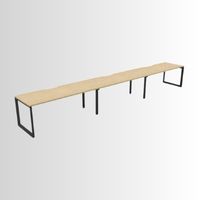 Modular Workstations
Shop Now >
Modular Workstations
Shop Now >
Workstations
Shop Workstations for your Office with Cavan!
Check out our range of Workstations for your office!
We offer Modular, Back to Back and Corner Workstation Solutions to suit all requirements and physical spaces.
Office workstations refer to individual work areas within an office setting where employees perform their tasks and duties.
These workstations are designed to provide employees with a functional and comfortable space to work efficiently and productively.
Soft Wiring solutions can assist with providing flexibility with your desking layout, while Screens can assist in adding privacy where needed.
Layout and Configuration
Office workstations can vary in layout and configuration depending on the organization's needs and space constraints. They may include cubicles, open-plan workstations, benching systems, or private offices, each offering different levels of privacy, collaboration, and interaction among employees.
Modularity and Flexibility
Many office workstations are designed with modularity and flexibility in mind, allowing for easy customization and reconfiguration as organizational needs change over time. Modular components such as desks, partitions, storage units, and accessories can be rearranged or added to accommodate evolving work requirements and team dynamics.
Ergonomics
Ergonomic considerations are essential in office workstation design to promote employee health, comfort, and productivity. Workstations should be adjustable to accommodate different body types and preferences, with features such as adjustable desk height, ergonomic chairs, keyboard trays, monitor arms, and footrests to support proper posture and reduce the risk of repetitive strain injuries.
Storage and Organization
Effective storage solutions are integral to office workstations to help employees stay organized and maximize available space. Storage options may include filing cabinets, shelves, drawers, overhead bins, and desktop organizers to keep documents, supplies, and personal items within easy reach.
Technology Integration
Office workstations often incorporate technology elements to support modern work practices and connectivity requirements. This may include integrated power outlets, USB ports, cable management systems, and data connectivity to facilitate seamless access to electronic devices and network resources.
Aesthetic Appeal
Office workstations contribute to the overall aesthetic of the workplace environment and reflect the organization's brand identity and culture. Thoughtful design elements such as color schemes, finishes, materials, and furniture choices can create a cohesive and visually appealing workspace that inspires creativity and collaboration among employees.
Acoustic Considerations
Noise management is an important aspect of office workstation design to minimize distractions and promote concentration and focus. Acoustic panels, sound-absorbing materials, and strategic placement of workstations can help mitigate noise levels and create a more conducive work environment.
Collaboration Zones
In addition to individual workstations, modern office layouts often include designated collaboration zones or shared spaces where employees can gather for meetings, brainstorming sessions, or informal discussions. These zones may feature communal tables, lounge seating, whiteboards, and multimedia equipment to support collaboration and teamwork.
In summary, office workstations play a critical role in providing employees with functional, comfortable, and productive work environments that support their individual needs and collective goals.
By incorporating ergonomic principles, flexible design features, and technology integration, office workstations can help organizations optimize space utilization, employee well-being, and overall workplace effectiveness.























